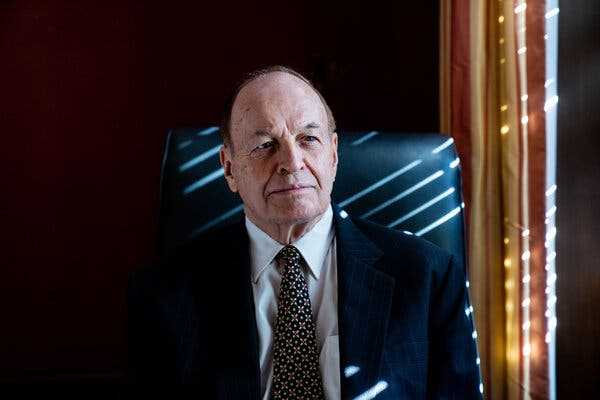Senator Richard C. Shelby made the most of his perch on the committee that controls federal spending. Now he’s leaving Congress, where his way of doing business is a fading art.
-
Send any friend a story
As a subscriber, you have “>10 gift articles to give each month. Anyone can read what you share.
Give this articleGive this articleGive this article

Senator Richard C. Shelby is set to retire after more than four decades representing Alabama in Congress.
SHELBY POINT, Ala. — For the first time in years, there are signs of dramatic transformation on the banks of the Mobile River. The waterway is dug wider and deeper by the day. Mobile’s airport will soon move in. And sitting watch from the waterfront is a three-foot bronze bust of the man who brought home the money to finance it: Senator Richard C. Shelby.
Determined to the point of obsession to harness the potential of Alabama’s only seaport, Mr. Shelby, who has served in Congress for more than four decades, has used his perch on the powerful committee that controls federal spending to bring in more than $1 billion to modernize the city’s harbor, procuring funding for projects including new wharves and better railways. The result is one of the fastest-growing ports of its kind, which today contributes to one in seven jobs in the state.
It is also something of a monument to a waning way of doing business on Capitol Hill, one that has fueled many a bipartisan deal — including the $1.7 trillion spending bill that cleared Congress last week, averting a government shutdown — and whose demise has contributed to the dysfunction and paralysis that has gripped Congress in recent years.
Mr. Shelby, who is retiring at 88, is one of the last of the big-time pork barrel legends who managed to sustain the flow of money to his state even as anti-spending fervor gripped his party during the rise of the Tea Party and never quite let go.
The Alabama senator did not just use his seat on the Appropriations Committee to turn the expanding port into an economic engine. Applying his influence, seniority, craftiness and deep knowledge of the arcane and secretive congressional spending process, he single-handedly transformed the landscape of his home state, harnessing billions of federal dollars to conjure the creation and expansion of university buildings and research programs, airports and seaports, and military and space facilities.
ImageMr. Shelby at a groundbreaking ceremony for a Mobile, Ala., airport. He has focused much of his energy on securing federal money for the area.Credit…Charity Rachelle for The New York Times
Mr. Shelby honed his tactics at a time when lawmakers across the political spectrum were willing to set aside ideology and unite behind a common zeal for grabbing federal money for their states and districts. That smoothed the path to passing major spending deals and keeping the government running in large part because those lawmakers had a vested interest in securing wins for their constituents.
He unapologetically followed in the footsteps of predecessors known in congressional parlance as “old bull appropriators,” like Republican Ted Stevens of Alaska, Democrats Robert C. Byrd of West Virginia and Daniel K. Inouye of Hawaii. They saw their primary task in Congress as steering as much money as they could to their states, which they saw as neglected in favor of more populous ones with more influence.
“They trained me,” Mr. Shelby said.
The ascendant right-wing Republicans who wield the greatest influence in Congress these days have received different training altogether.
They are lawmakers who reflexively vote against any federal funding measure and regard big spenders like Mr. Shelby as establishment stooges who have been corrupted by the lure of wasteful government spending. And as the party prepares to assume the House majority next week, they have made it clear that they will demand severe cuts, potentially leading to the kind of spending stalemate that has become commonplace in recent years.
What’s In the $1.7 Trillion Spending Bill
Card 1 of 7
A sprawling package. Top lawmakers unveiled a roughly $1.7 trillion spending package that would keep the U.S. government open through September. Here is a look at some key provisions in the 4,155-page bill:
Military spending is the big winner. The Defense Department would see an extraordinary surge in spending when adding its regular 2023 fiscal year budget together with additional aid for Ukraine. All together, half of the funding included in the bill goes to defense, or a total of $858 billion.
Making it easier (for some) to save for retirement. The package includes new provisions that would alter how millions of Americans save for retirement, including older people who want to stash away extra money before they stop working and those struggling under the weight of student debt.
Overhauling the Electoral Count Act. The legislation includes an overhaul of the 135-year-old law. Supporters of former President Donald J. Trump sought to exploit ambiguities in the law to disrupt the traditionally ceremonial counting of the presidential electoral ballots on Jan. 6, 2021.
A ban on TikTok on government devices. TikTok will be banned from all federal government devices under the bill. The move is intended to assuage heightened privacy and national security concerns about the app, which is owned by the Chinese company ByteDance.
International climate finance loses out. The bill includes just $1 billion to help poor countries cope with climate change. The figure falls far short of President Biden’s promise that the United States would spend $11.4 billion annually by 2024 to help developing nations adapt to a warming planet.
Other provisions. The bill also contains increased funding for the police, billions in aid for communities ravaged by natural disasters and a win for the lobster industry over whales. Read more about what’s in the bill, including more than $15 billion in earmarks.
“Other people would say, ‘Oh you shouldn’t do anything for your state, you shouldn’t spend any money on this.’ I differ with that,” Mr. Shelby said last week, sitting in his office in Washington, feet away from his desk that once belonged to another Southern senator who used his perch in Congress to build his state, Lyndon B. Johnson.
Part of the task of a senator, he argued, is to help build the conditions for his state’s prosperity.
“I’m a pretty conservative guy in a lot of ways,” Mr. Shelby said. “But I thought that’s the role Congress has played since the Erie Canal.”
As Mr. Shelby’s contributions have sprung up across his home state, so too have the monuments in his honor. Beyond the statue at the Port of Mobile, which was unveiled early this month, there are no fewer than seven buildings in Alabama named for him — mostly academic buildings, but also a missile intelligence center. An eighth, a federal courthouse, is on the way.
“No one will ever accuse Richard Shelby of being timid or thinking small,” said Jo Bonner, the president of the University of South Alabama, and a former Republican congressman who served five terms. The senator’s ability to “dream big and look years down the road,” he said, made Mr. Shelby “the most consequential elected official in Alabama history.”
Bradley Byrne, the former Republican congressman from Mobile, recalled marveling when he first arrived to Congress at how thoroughly Mr. Shelby had stuffed the year-end spending bill.
“Senator, you got a whole lot of stuff for Alabama in that bill,” Mr. Byrne recalled telling Mr. Shelby.
“Bradley,” Mr. Shelby replied in his signature baritone drawl, “I got everything.”
Born in Birmingham during the Great Depression, Mr. Shelby said he had never even met a Republican growing up. A lawyer by trade, he began in politics as a conservative Democrat, first in the Alabama Senate, then as a U.S. congressman. By the time Mr. Shelby had climbed the ranks of seniority in the Senate, becoming the chairman of the appropriations panel after helming three others, including the Intelligence Committee, he had changed parties as part of the vanguard of the Southern realignment.
ImageMr. Shelby is one of the last of the big-time pork barrel legends who managed to sustain the flow of money to his state even as anti-spending fervor gripped his party.Credit…Haiyun Jiang/The New York Times
Outside of his push for federal money, Mr. Shelby legislated and voted like a conventional conservative when it came to social and economic issues, and his relationship with the Clinton administration soured when, in 1993, he greeted the new president’s economic plan with the memorable phrase: “The taxman cometh.”
His enthusiasm for earmarks has long drawn detractors. Citizens Against Government Waste, a nonpartisan organization that opposes the use of earmarks, once published a report titled “Senator Shelby’s pork parade.”
“Senator Shelby has long used his seniority on the Appropriations Committee to receive far more earmarks than his peers,” including last year, “when he received nearly twice as many dollars in earmarks as the next-highest recipient,” said Sean Kennedy, the group’s director of policy and research.
Even as the term “earmark” became a four-letter word in his party in the 2000s, Mr. Shelby remained unabashed about the parade of federal funds he steered his state’s way. When local cartoonists published images of Mr. Shelby depicting him as one of the state’s chief benefactors, such as one of Mr. Shelby carrying a pig in a large sack bearing a money symbol captioned, “Alabama’s Santa Claus,” his wife would display them at their home. It was a reminder, Mr. Shelby said, “to keep my humor.”
Mr. Shelby’s work was about “trying to make sure we got our fair share,” said Sandy Stimpson, the mayor of Mobile, where an estimated one in five people lives in poverty.
Mr. Shelby has funded roads and bridges and hospitals and public libraries and drinking water systems; university research into topics as varied as the prevention of diseases in local foods like catfish and oranges, to improved monitoring systems for coastal flooding and hurricanes, to the combustion behavior of liquid oxygen.
For some of his biggest priorities — such as the Redstone Arsenal, the military installation near Huntsville that houses Army missile programs, the F.B.I., and the Marshall Space Flight Center — Mr. Shelby secured vast infusions of federal funds bit by bit each year, shoehorning them into bill after bill over the course of decades.
“I thought the best thing I could do with federal money was not pave somebody’s driveway,” Mr. Shelby said. What he tried to do instead was “to build institutions, and then infrastructure that would create more of a competitive environment for the long run.”
At Redstone Arsenal, he successfully lobbied the Air Force to build the new U.S. Space Command’s headquarters, and pushed the F.B.I. to expand its footprint there, an investment that has now topped $2.48 billion, much of it built by earmarks. And he sent billions of dollars to support research and expand jobs at NASA’s civilian rocketry and spacecraft propulsion research center there.
Sometimes his advocacy came in the form of a few paragraphs. In 2011, when lawmakers were rushing to approve a short-term spending bill to ensure the government did not shut down, Mr. Shelby tucked in language that blocked NASA from scrapping an effort to commission rockets with “heavy-lift” capabilities, a move that would have eliminated hundreds of jobs at Redstone Arsenal.
Mr. Shelby, in part for personal reasons, has also taken a special interest in Alabama’s universities, which have been some of the biggest beneficiaries of his largess. In 1987, during Mr. Shelby’s first year in the Senate, his wife, the first woman to become a tenured professor at Georgetown University’s business school, suffered kidney failure from lupus. The family turned to the medical staff at the University of Alabama, Birmingham.
“U.A.B. saved her life,” Mr. Shelby says now. “I realized what they had there, and could have there.”
ImageA bust at the Port of Mobile is one of the many monuments that have sprung up in Mr. Shelby’s honor.Credit…Charity Rachelle for The New York Times
Since then, Mr. Shelby has secured funding for four academic buildings — all of them hubs for scientific research and teaching, none of them smaller than 150,000 square feet, and most built in the federal style with Doric columns. There is Shelby Hall at the University of Alabama; Shelby Hall at the University of South Alabama; the 12-story, 340,000 square foot Shelby Biomedical Research Building at the University of Alabama, Birmingham; and the Shelby Center for Science and Technology at the University of Alabama, Huntsville, two-thirds of which was built with federal funds.
At Tuscaloosa, more than $60 million secured by Mr. Shelby helped build what became one of the largest academic buildings on the University of Alabama campus, a 200,000-square-foot hall that houses more than 70 research labs, three lecture halls and more than 120 offices for faculty and graduate students.
“It allowed us to put students in laboratory facilities that otherwise they would not have been able to be a part of,” said Dr. Chuck Karr, the president of the University of Alabama, Huntsville, and a previous engineering dean at the University of Alabama. “It really served as the catalyst for other growth.”
When local officials unveiled the bust of Mr. Shelby at the Port of Mobile earlier this month, they also surprised him by announcing that they were privately financing two engineering and computing scholarships in his name at the University of South Alabama.
Seated in his office weeks later, he was more interested in talking about the scholarships than the twice-life-size bronze edifice modeled after him.
“If you have tried to educate everybody in your community — everybody,” Mr. Shelby said, “you’re going to create opportunity.”
Statues, he said with a mischievous glint in his eye, “are for dogs and birds.”
Source: nytimes.com



